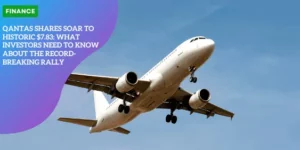From Seoul to Palau: Qantas’ Strategic Shift in International Flight Network
Discontinuation of Sydney-Seoul Flights
As part of its international route network overhaul, Qantas will discontinue its Sydney-Seoul flights in mid-June next year.
This move comes less than three years after launching services to South Korea.
The decision to cut this route enables Qantas to reallocate its fleet to destinations with stronger demand, optimizing its resource utilization and enhancing operational efficiency.
Introduction of ‘Palau Paradise Express’ Service
Qantas will introduce a new service, the ‘Palau Paradise Express’, offering weekly flights between Brisbane and Palau.
This service is part of a federal government contract, emphasizing Qantas’ commitment to expanding its international footprint while fostering trade and tourism links between Australia and Palau.
The new destination adds another layer of excitement for Qantas customers, who can look forward to exploring the pristine waters and unique marine life of Palau.
Reallocation of Resources to High-Demand Routes
The strategic withdrawal from the Sydney-Seoul route aligns with Qantas’ broader effort to reallocate resources to high-demand routes.
By focusing on routes where demand is stronger, Qantas aims to optimize its fleet usage.
This strategic shift allows Qantas to better serve its passengers, ensuring higher load factors and maximizing revenue potentials.
Notably, Qantas will also enhance its fleet planning by deploying various aircraft types tailored to specific route demands, thereby meeting the needs of both leisure and business travelers more effectively.
To navigate rapidly changing travel demands and ensure operational efficiency, Qantas is dynamically aligning its route network and resources. This forward-thinking approach underscores their commitment to maintaining a robust global presence.
Expansion of Jetstar’s Role
Increase in Jetstar’s Sydney-Seoul Flight Frequency
As part of Qantas’ strategic overhaul, the discontinuation of Sydney-Seoul flights by the mainline Qantas service is a significant shift.
However, this gap is being swiftly filled by Jetstar’s increased presence on this route.
Jetstar will elevate its flight frequency from four times per week to daily operations.
This not only maintains connectivity but leverages Jetstar’s budget-friendly model, making it more viable for leisure travelers heading to Seoul.
Shift Towards Leisure Market for the Seoul Route
The decision to hand over the Sydney-Seoul route to Jetstar underscores a shift in market focus.
Seoul has emerged as a vibrant leisure destination post-pandemic, with substantial growth in demand from tourists.
Jetstar is well-positioned to cater to this market segment, providing affordable travel options that align with the expectations of leisure travelers.
This shift ensures that Qantas Group can better cater to various market segments, with Jetstar focusing on leisure while Qantas can redirect resources to more premium or high-demand routes.
Qantas Group’s Strategy for Market Segmentation
One of the key strategic advantages of having both Qantas and Jetstar under one umbrella is the ability to segment the market effectively.
By reallocating the Sydney-Seoul route to Jetstar, Qantas Group can optimize its resource allocation.
This strategic move allows Qantas to focus on routes that demand premium service levels and higher revenue potential, while Jetstar captures the growing demand in the leisure travel market.
This synergy strengthens the overall network and ensures that the Qantas Group remains competitive across different market segments.
This effective segmentation will further be bolstered by upcoming new routes and partnerships that align with Qantas’ broader strategic goals.
New Destinations and Government Partnerships
Launch of Brisbane-Palau Weekly Flights
Qantas’ strategic overhaul includes the introduction of the ‘Palau Paradise Express’ service, set to offer weekly flights between Brisbane and Palau.
This move marks the airline’s initial foray into the Micronesian market.
Designed to enhance Australia-Palau connections, the new route will bolster tourism and open up a unique and pristine destination to travelers.
Palau is famed for its crystal-clear waters, diverse marine life, and adventure tourism, making it a haven for diving and hiking enthusiasts.
Federal Government Contract for Palau Service
This new service between Brisbane and Palau falls under a federal government contract, ensuring strong trade and tourism links between the two nations.
The Australian government aims to strengthen diplomatic relations and facilitate economic exchanges, while Qantas stands to benefit from a steady demand for this route initiated by the contract.
This government-backed service assures a balanced and sustainable operation, even as travel trends fluctuate.
Strengthening Trade and Tourism Links with Palau
The Brisbane-Palau route is more than just a novel addition to Qantas’ international network; it represents a concerted effort to amplify trade and tourism ties.
The strategic introduction of this flight route not only caters to tourists but also supports economic ventures and cultural exchanges between Australia and Palau.
Through these enhanced connections, both countries anticipate mutual benefits and a deeper bilateral relationship.
With these new introductions, Qantas continues to evolve and adapt, focusing keenly on establishing impactful routes that promise both commercial viability and unique travel experiences.
Fleet Optimization and Route Adjustments
Deployment of Airbus A220 on Darwin-Singapore Route
Qantas is deploying the Airbus A220 on the Darwin-Singapore route, marking its debut in international operations for this aircraft.
Starting March 30 next year, the A220 will operate five times a week, replacing the Embraer E190 initially planned for this route.
The A220’s advanced fuel efficiency and state-of-the-art passenger amenities make it a suitable choice for this connection, enhancing both fuel savings and customer experience.
Mix of Aircraft Types on Various International Routes
Qantas is also blending different aircraft models across its international routes to optimize efficiency and service.
Key adjustments include the reintroduction of the Brisbane-Noumea route from December 14 and increasing Melbourne-Dallas flights from three to four weekly starting February 6.
Additionally, Brisbane-Los Angeles will see a mix of Airbus A330 and Boeing 787 aircraft from August 11, while Sydney-Dallas will operate with both Airbus A380 and Boeing 787 aircraft.
The Brisbane-Auckland route will also welcome the Boeing 787, reflecting a versatile approach to fleet management.
Reintroduction of A380s to Meet Premium Seat Demand
To cater to the growing premium travel market, Qantas is reintroducing its Airbus A380 fleet on select routes.
These aircraft, known for their luxurious amenities and expanded seating capacity, will help meet the increasing demand for premium cabin seats.
This move aligns with Qantas’ strategy to offer a superior flying experience on popular international routes, bolstering its market position in the competitive premium travel segment.
As Qantas fine-tunes its operations and fleet composition, these adjustments set the stage for enhanced connectivity and customer experience, further solidifying its international presence.
Capacity Increase and Network Enhancements
Qantas is embarking on a significant capacity expansion within its international network, a strategic move aimed at meeting increasing customer demand.
To achieve this, the airline is adding 220,000 seats across its international services over the next twelve months.
This swell in capacity reflects Qantas’ commitment to better connect travelers to key destinations and enhance their flying experience.
Addition of 220,000 Seats
The augmentation of 220,000 seats on international routes is a cornerstone of Qantas’ strategy.
It underscores the airline’s effort to scale up operations and provide ample travel options to its customers.
This increase will support growing demand and ensure that more travelers have the opportunity to experience Qantas’ services.
Adjustments to Flight Frequencies
Qantas is also refining its flight schedules to better align with market needs.
For instance, Melbourne-Dallas flights will increase from three to four per week starting next year.
Conversely, services from Sydney to New York via Auckland will reduce from six to five weekly flights.
This fine-tuning showcases Qantas’ adaptive approach to optimizing its resources and meeting travel demand patterns on specific routes.
Aligning Aircraft Type with Route Requirements
With the goal of enhancing operational efficiency and catering to various market segments, Qantas is deploying the right aircraft on the right routes.
The introduction of the Airbus A220 on the Darwin-Singapore route and the use of a mix of Airbus A330 and Boeing 787 aircraft on Brisbane-Los Angeles flights are prime examples.
Additionally, the reintroduction of A380s boosts the number of premium seats available, catering to high-end travelers.
These strategic enhancements signal Qantas’ readiness to meet evolving travel demands while balancing the needs of established and emerging markets.
Future Outlook and Strategic Implications
Responding to evolving travel demands is a key component of Qantas’ future strategy.
By analyzing current market trends, Qantas is shifting its focus towards routes with higher demand and emerging markets that present new opportunities.
This strategic realignment aims to ensure the airline remains competitive and continues to offer compelling options for travelers.
Balancing Established and Emerging Markets
Qantas is striking a balance between established and emerging markets.
While it continues to serve well-trodden routes, the airline is also venturing into lesser-known destinations like Palau.
This balance helps Qantas maintain its stronghold in traditional markets while capitalizing on the growth potential in new areas.
Enhancing connections, such as the introduction of flights between Brisbane and Palau, also represents Qantas’ commitment to expanding its global footprint.
Long-term Vision for Global Presence and Operational Efficiency
Qantas’ long-term vision revolves around operational efficiency and a robust global presence.
This involves deploying the right aircraft on the right routes, like using the Airbus A220 on the Darwin-Singapore route for enhanced fuel efficiency and customer comfort.
It’s also about tapping into market segmentation, with Qantas focusing on premium routes while Jetstar caters to leisure travelers, particularly on high-demand routes to destinations like Seoul.
By continually optimizing its fleet, adjusting route networks, and increasing overall capacity to meet customer demand, Qantas aims to solidify its status as a leading global airline.
This strategy ensures that Qantas remains adaptable, responsive, and forward-looking.
In conclusion, these strategic initiatives position Qantas for sustained growth, helping it meet current and future travel demands while remaining agile in a competitive industry.







